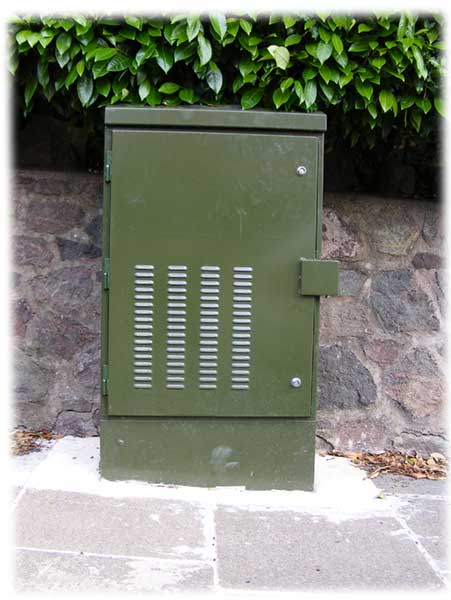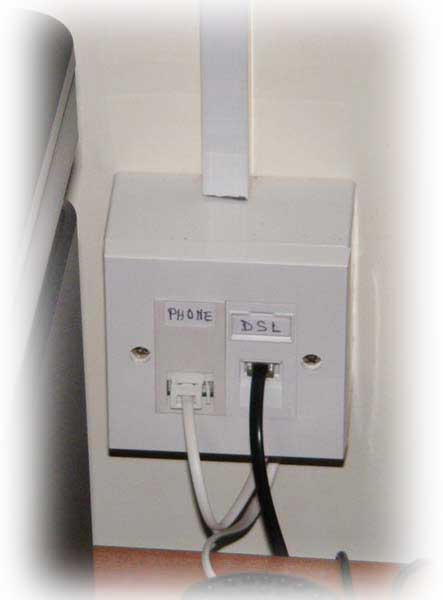
Angus and Rosemary's Miscellany
of Malvern - Other Resources
|
Blogs > BT broadbandHere are a few words about our experience as satisfied customers of BT Broadband. If you have experience of other providers in the Malvern Hills area feel free to let us know what you think. BackgroundIn the 1950s, if you were lucky, the family had a large bakelite telephone and, when you lifted the handset, you had to tell the operator what number you wanted to be connected to. It was not until the 1960s that Malvern got an automatic exchange and phones with dials. By the 1980s we had a dial telephone screwed to the wall in our kitchen, connected directly to the BT line; no master socket in those days. When we moved in the 1990s the new house had a BT master socket into which was plugged a push button phone - very modern, we thought. Data communications for businesses in the 1950s was typically by means of a dial up connection between electromechanical teleprinters operating at no more than 10 characters per second. It was not until the 1970s that research labs started dabbling with packet switching as a better means of data-communications, examples being the US ARPANET, and the JANET network connecting universities. In the 1990s businesses became progressively involved, building networks to which the public could connect, and so it was that the Internet was born. By the year 2000, BT was offering dial-up connections into the Internet. Modems only offered up to 56 Kb/s, but that in itself was a miracle, as at the time audio telephone circuits of 3 KHz bandwidth would not normally be expected to provide much more than 300 bits per second. A big disadvantage was that if your phone was connected to the Internet, you could not make calls and nobody could call you. About 2006 we upgraded to BT Broadband. With this, the copper twisted pair cable carries both the voice signal, and data as radio frequency modulation, from the exchange; the signals are separated by a low pass ADSL filter, with the RF modulation being converted to binary data by a router. As the distance from the exchange increases the signal gets weaker, and the maximum achievable data rate correspondingly reduces. BT estimated we would get between 2 and 4 Mb/s, being about 2 miles from the exchange, and in fact we got 2 Mb/s, which was a huge improvement over dial-up. Our first router was a plug in job, but circa 2010 we took another leap forward by upgrading to a secondhand Wi Fi enabled BT Home Hub 1, which was surplus to the requirements of another member of the family. BT Infinity
Luckily, Malvern was one of the first areas chosen for deployment and you will now find many FTTC cabinets scattered round the town. See photo opposite of distinctive cabinet on the corner of Albert Road. The Internet signal travels to the FTTC cabinet through a high speed fibre optic cable and is then piggy backed onto the local copper subscriber line. While you might typically get 50 Mb/s near the cabinet the signal drops rapidly the further you are away. Our home is about 1Km away from the cabinet and we now get 14 Mb/s which is seven times faster than our previous broadband. Neighbours tell us speeds of 24 Mb/s are possible at Wykewane, and 50 Mb/s using BT's fastest Broadband in Eston Avenue and some areas of Malvern Link. Upgrading to BT InfinityA few words about the upgrade process. For years we had found the cheapest 2 Mb/s Broadband with a 10 GB monthly limit quite adequate for email, browsing the Internet, and very occasionally watching catch up TV on the BBC iplayer - though having to use the lower bandwidth setting with reduced picture size. However circa 2015 we upgraded to unlimited Broadband to take account of visitors watching videos, and automatic updates to Windows 10. After the FTTC cabinet was installed at Hall Green we started getting regular invitations from BT to upgrade to BT Infinity. In those early days it seemed we would need an engineer to visit to fit a filtered faceplate to the master socket, an extension lead from the master socket in the loft to the computer, a BT Infinity modem and a router. Circa 2016 we received a special offer to sign up for BT Infinity and decided to take the leap. Times had moved on, and we found BT Infinity was now a self install job, and that the Modem and Router functions had been combined in the new BT Smart Hub 6. Two weeks later the new Smart Hub arrived by Royal Mail. The box contained just the Smart Hub and its power supply but surprisingly no filter or leads. We were told to plug the Smart Hub into the BT master socket, in place of the old Home Hub straight away. Instead we could only plug the Smart Hub in to the extension by the computer connected to the master box in the loft. We did this and our (basic) Broadand download speed fell from 2 Mb/s to 1.3 Mb/s. The next day, when we switched on, BT Infinity was already activated and the download speed was increased to about 10 Mb/s. BT had estimated we should get between 20 and 27 Mb/s and a minimum of 17 Mb/s.
Photo right: RJ45 data socket and back box with Crabtree BT socket fitted in place of blanking plate (sourced from Screwfix). The next logical step was to run the BT speed checker. If you type the Smart Hub IP address into your browser, you will be presented with its status, and one of the options is to run a Broadband performance check. Selecting this takes you to the BT website where you are invited to log in with your username and password. The speed checker suggested some improvement should be possible, then it went through a BT line check and BT broadband check. No faults were immediately found, but after clicking to indicate the router was connected to the master socket, the speed checker later reported there was a broadband fault outside the property and that a repair team would be tasked. The very next day an Open Reach engineer called (unannounced) to investigate. He plugged a tester into the master socket which indicated a bad joint about 80 metres away, near the end of our overhead line. Further tests in the manhole below the telegraph pole indicated the fault was where two cables were spliced together part way up the pole. Here the cable was protected by a sturdy steel cover, so the work-around was to patch into a spare pair in the multi-pair cable. The test box then indicated that the line should now be capable of 15 Mb/s, although the engineer thought it was currently capped at 10 Mb/s by BT. After the engineer left the line speed increased to 14 Mb/s which we are very happy with - so WELL DONE BT. Broadband in remote villagesIf you live outside towns you are unlikely to get fast broadband. When this article was first drafted Madresfield Primary School was only getting of the order of 1 Mb/s, and when you consider that might have to be shared between a class of thirty or so children, that is quite inadequate. As far as we know BT had no solution to this problem except charging a lot of money for extending fibre to the village. Do let us know if this issue has either been fixed or you can recommend a cost effective solution. Our son in Lanarkshire, Scotland is about 2 miles from the Tinto exchange at Thankerton and had been getting between 1 and 2 Mb/s, but during wet weather the broadband has on occasion dropped out completely or been unreliable. At one time the unreliability of his broadband connection was affecting his business, but for over 2 months BT in Scotland seemed unable to trace the fault, and didn't seem to care, seemingly taking the attitude you shouldn't expect a reliable connection in rural areas. A similar situation pertains locally, at the village of Little Clevelode, where some customers moved to TalkTalk, who have 'dumped' rural customers and sold that segment of their business to Fleur Telecom, part of the Daisy Group. So it would appear the service you get very much depends on where you live. In Malvern we are generally very lucky and get good speeds, whereas in most rural areas broadband speeds needs to be increased. By the way we are told if you are having problems with your Broadband it's no good just checking your phone works as the digital Broadband signal is more susceptible to poor connections and noise.
Previously updated 29th September 2016 |
|
Last updated 16th November 2018 |
 The Blair
Government pushed for faster broadband of
at least 10 Mb/s to become widely available across the country and the
technology to bring this to most homes was Fibre To The Cabinet, abbreviated
to FTTC, sometimes also referred to as very high bit rate digital subscriber
line, abbreviated to VDSL.
The Blair
Government pushed for faster broadband of
at least 10 Mb/s to become widely available across the country and the
technology to bring this to most homes was Fibre To The Cabinet, abbreviated
to FTTC, sometimes also referred to as very high bit rate digital subscriber
line, abbreviated to VDSL. Thinking
the house wiring could be at fault we fitted a data faceplate to the master
socket and ran a 10 metre cat 5e twisted pair cable through the loft to an
RJ45 socket into which we plugged the Smart Hub RJ11 lead. After doing this
the download speed was still 10.0 Mb/s.
Thinking
the house wiring could be at fault we fitted a data faceplate to the master
socket and ran a 10 metre cat 5e twisted pair cable through the loft to an
RJ45 socket into which we plugged the Smart Hub RJ11 lead. After doing this
the download speed was still 10.0 Mb/s.